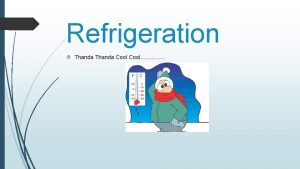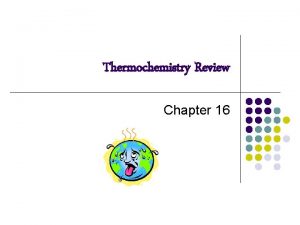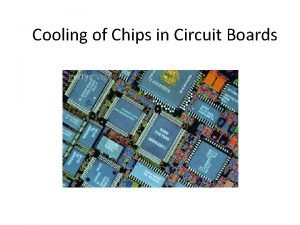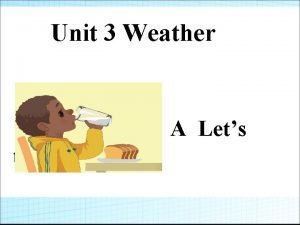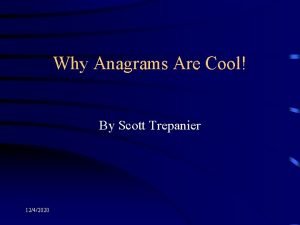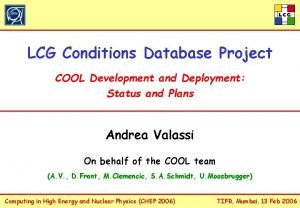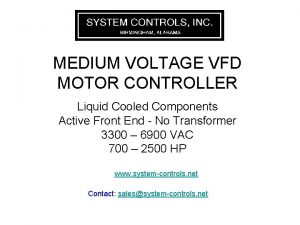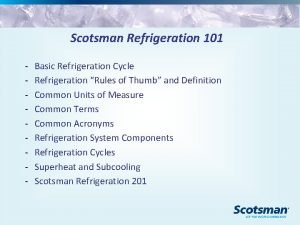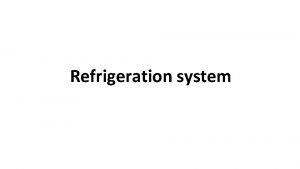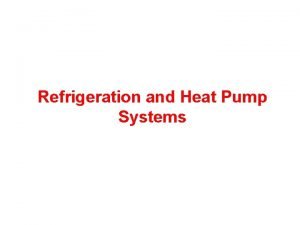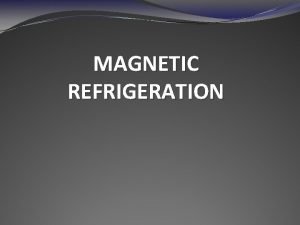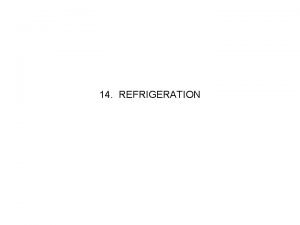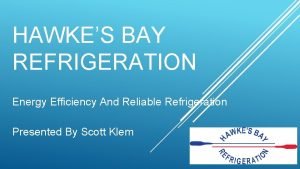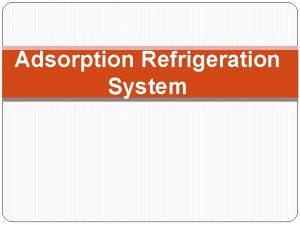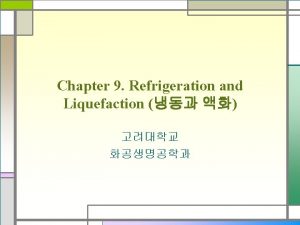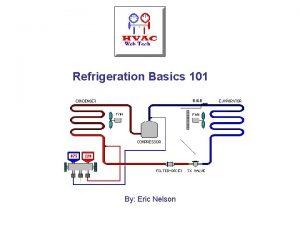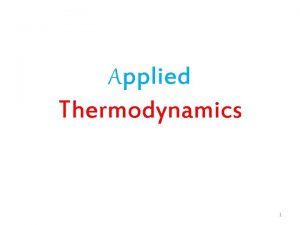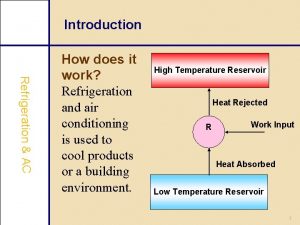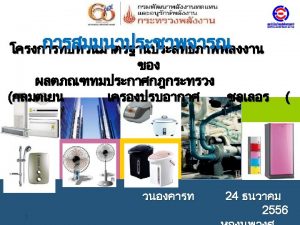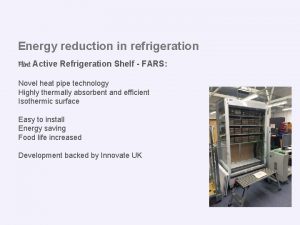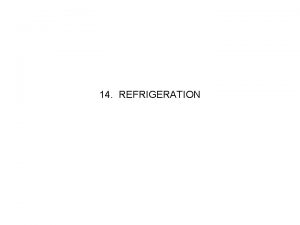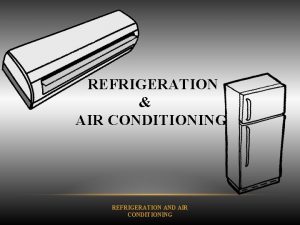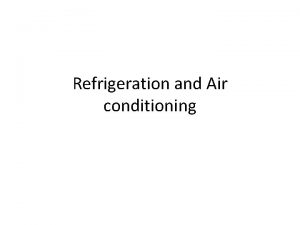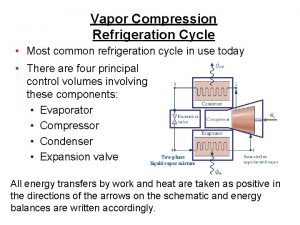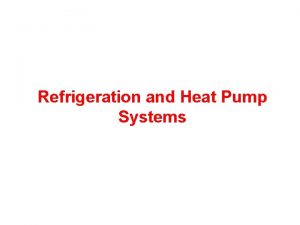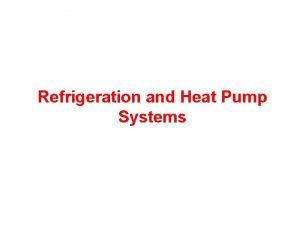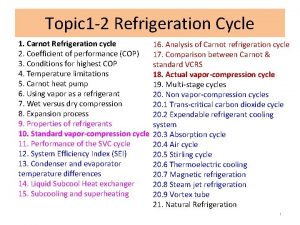Refrigeration Thanda Cool What is Refrigeration Refrigeration is





























- Slides: 29

Refrigeration Thanda Cool………….

What is Refrigeration? ? Refrigeration is the process of removing heat from substance or space to reduce its temperature and transferring that heat to another substance OR Refrigeration is providing and maintaining the temperature below that of the surrounding temperature. Unit Of Refrigeration: The Capacity of a refrigeration unit is expressed in terms of Ton. One ton of refrigeration is equivalent to the heat of fusion absorbed by melting 1 short ton (2, 000 lbs. ; 0. 893 long tons; 0. 907 t) of pure ice at 0 °C (32 °F) in 24 hours.

History Of Refrigeration

THE EARLY FRIDGE Ø The hole dug into the ground which was cooler than the surrounding area which protected food that much more. Ø Then they created structures like these to store ice cut from frozen ponds from the warmer air. Ø The shape and design would change from climate or geography or the culture that built it. Ø In 1913 fridges for home and domestic use were invented by Fred W. Wolf it later became the base for another. Ø Then in 1916 Alfred Mellows who’s idea was bought by William C. Durant to make the first massproduction of fridges. Ø In 1918 the first fridge with any type of automatic temperature control was invented.

THE FIRST MODERN FRIDGE Ø In 1748 the first known artificial refrigeration was designed and shown by Oliver Evans. Ø The first device able to make 1 ton of ice was in 1853. Ø The introduction of Freon in the 1920 s expanded the refrigerator market during the 1930 s and provided a safer , low-toxicity alternative to previously used refrigerants. Ø The first refrigerator to see widespread use was the General Electric “Monitor-Top” refrigerator introduced in 1927 nicked named after the monitor like top of the USS monitor.

Over the years the fridge has changed to the way it is today.

Refrigeration Equipment

Components Of Refrigeration System: Refrigeration system consists of: 1)Compressors 2)Condensers 3)Evaporators 4)Expansion devices

Compressor A refrigerant compressor is a machine used to compress the refrigerant from the evaporator and to raise its pressure so that the corresponding temperature is higher than that of the cooling medium. Types of compressors: Open Type compressor. Semi-Hermetically compressor. Hermetically sealed compressor.

Condenser The condenser is a device used in the high pressure side of a refrigeration system. Its function is to remove heat of the hot vapor refrigerant discharged from the compressor. Types: (a) Air- cooled, (b) Water-cooled and (c) Evaporative. As their names imply, air-cooled condensers use air as the cooling medium, water -cooled condensers use water as the medium and the evaporative condenser is a combination of the above, i. e. uses both water and air.

Evaporators The process of heat removal from the substance to be cooled or refrigerated is done in the evaporator. The liquid refrigerant is vaporized inside the evaporator (coil or shell) in order to remove heat from a fluid such as air, water etc. Types: (a)Dry expansion evaporator (b)flooded evaporator

Expansion Devices The expansion device which is also known as throttling device, divides the high pressure side and the low pressure side of a refrigeration system. It is connected between the receiver and the evaporator Types: (a) Capillary tube, (b) Float valves, (c) Thermostatic expansion valve

Overall Refrigeration System

METHODS OF REFRIGERATION

Refrigeration can be classified into two types : 1. Natural method 2. Artificial or Mechanical Refrigeration 1. Natural method: The natural method includes the utilization of ice or snow obtained naturally in cold climate. Ice melts at zero degree centigrade. So, when it is placed in a system or space warmer than that temperature, heat is absorbed by the ice and the space is cooled. The different methods of natural refrigeration include: § Use of ice transported from colder regions § Use of ice harvested in winter and stored in ice houses § Use of ice produced by nocturnal cooling § Use of evaporative cooling § Cooling by salt solution

2. Artificial or mechanical refrigeration: This consists of a refrigeration cycle , where heat is removed from a low temperature space or source and rejected to a high temperature sink with the help of external work. Heat naturally flows from hot to cold. Work is applied to cool a living space or storage volume by pumping heat from a lower temperature heat source into a higher temperature heat sink. Different types of artificial refrigeration include: a) Vapor compression refrigeration b) Vapor absorption refrigeration c) Gas cycle refrigeration d) Thermoelectric refrigeration e) Magnetic refrigeration

Vapor compression refrigeration: The vapor compression cycle is used in most household refrigerators as well as in many large commercial and industrial refrigeration systems. § In this method, a circulating refrigerant such as Freon enters the compressor as a vapor during which it is compressed at constant entropy and exits the compressor as a vapor at a higher temperature. § This heated vapor travels through the condenser which cools the vapor and condenses it into a liquid by removing additional heat at constant temperature and pressure. § This liquid refrigerant now goes through the expansion valve or throttle valve, where its pressure abruptly decreases, which results in a mixture of liquid and vapor at a lower temperature and pressure. § This cold liquid vapor mixture then enters the evaporator coil and is completely vaporized by cooling the warm air being blown by a fan across the evaporator coil. § The evaporator is the main component of the system that produces the cooling effect by extracting heat from the working space. § The resulting refrigerant vapor returns to the compressor inlet and the cycle repeats.


b)Vapor absorption refrigeration: § This absorption cycle is almost similar to the compression cycle , except for the method of raising the pressure of refrigerant vapor. § In this, the compressor is replaced by an absorber which dissolves the refrigerant in a suitable liquid. § A liquid pump raises the pressure and a generator, which on heat addition, drives off the refrigerant vapor from the high pressure liquid. § A suitable combination of refrigerant and absorbent is used in this method. The most common combinations are ammonia as a refrigerant with water as an absorbent and water as refrigerant with lithium bromide as an absorbent. c)Gas cycle refrigeration: § In this, the working fluid is a gas that is compressed and expanded but doesn’t change phase. § Air is most often the working fluid. § As there is no condensation and evaporation, the components corresponding to the condenser and evaporator are the hot and cold gas-to-gas heat exchangers.

d)Thermoelectric refrigeration: § When an electrical current is applied across the junction of two dissimilar metals, heat is removed from one of the metals and transferred to the other. § Cooling is achieved electronically using the "Peltier" effect - heat is pumped with electrical energy. e)Magnetic refrigeration: § Magnetic refrigeration is also known as adiabatic demagnetization. § It is based on the principle of magnetocaloric effect § The refrigerant often used is a paramagnetic salt, such as cerium magnesium nitrate. § A strong magnetic field is applied to the refrigerant, forcing its various magnetic dipoles to align and putting the degrees of freedom of it into a state of lowered entropy. § A heat sink then absorbs the heat released due to its loss of entropy. § The application of this is limited to cryogenics and research because only a few materials exhibit the desired properties at room temperature.


Magnetic Refrigeration

Applications Of Refrigeration Central Air Conditioning Food Storage Making of ice Ice-Cream plants Industrial applications Hospital operation Theatre Research Laboratories Computer Rooms Production Of Rocket fuels(Cryogenic Fuel) Cryonics Project


Farm Use In order to reduce humidity levels and spoiling due to bacterial growth, refrigeration is used for meat production and dairy processing in farming today. Refrigeration systems are used heaviest in the warmer months for farming produce, which must be cooled as soon as possible in order to meet quality standards and increase the shelf life. Meanwhile, dairy farms refrigerate milk year round to avoid spoiling.

Some Examples 1. Ammonia Adsorption System: can be built with no moving parts and can require no work input. They operate with a heat input only. Ammonia absorption refrigerators are used industrially and in recreational vehicles. 2. Thermoelectric refrigeration systems: It uses the Peltier effect to absorb heat at the junction between two wires made of different metals. These devices are lightweight, but not very efficient.

Why does a domestic fridge freezer kept in an unheated area sometimes stop working? Standard domestic fridge freezers are designed to work in an ambient temperature of 10°C to 32°C, i. e. normal kitchen conditions. When temperatures drop below 10°C the fridge freezer will start having problems holding temperature in the freezer. This may result in the freezer turning off. This information is usually stated in the handbook that comes with the appliance. It is possible to buy fridge freezers that will work in an ambient of 0°C but they are normally more expensive and use an elaborate compressor and temperature sensing system. Problems are very common with fridge freezers kept in unheated areas such garages or out houses. There is only one way to overcome the problem and that is to have the appliance sited in ambient temperature that does not drop below 10 degrees. This would mean either heating your garage or moving the appliance inside the house.

So Then…What is the difference between air conditioning and refrigeration? ? Air conditioners and refrigerators are devices used to keep a space at a colder temperature than its surroundings. The main difference between refrigeration and air conditioning is that refrigeration, in general, refers to any process where thermal energy is taken away from a place and transferred to a place with a higher temperature. Air conditioning is a type of refrigeration where thermal energy is taken away from the air (typically in a room or a vehicle) in order to keep the air cooler. Process Refrigeration is a process where thermal energy is transferred from a place with lower temperature to a place with higher temperature using energy, against the natural flow of heat. Air conditioning is a type of refrigeration which is used to cool large volumes inhabited by people. Functions Refrigeration is concerned only with regulating the temperature of a volume of air. Air conditioning is concerned with not only maintaining the temperature of a volume of air, but also maintaining the humidity and purity.

Thank You
 Fridge thanda
Fridge thanda Cool molecules
Cool molecules Cool molecular structures
Cool molecular structures A piece of metal is heated then submerged
A piece of metal is heated then submerged Nty urban dictionary
Nty urban dictionary We real cool theme
We real cool theme A food handler pulled a hotel pan
A food handler pulled a hotel pan One way to cool chips mounted on the circuit boards
One way to cool chips mounted on the circuit boards Unit 3 weather
Unit 3 weather Tuning protocol worksheet
Tuning protocol worksheet Heroic age of antarctic exploration
Heroic age of antarctic exploration Guns n roses cool hand luke
Guns n roses cool hand luke The circular chart used to remember color relationship is a
The circular chart used to remember color relationship is a Managerial ethics
Managerial ethics Cool anagrams
Cool anagrams Plex jav
Plex jav Cool cap tedavisi
Cool cap tedavisi Bear hunt dr. jean
Bear hunt dr. jean Cool tools for teachers
Cool tools for teachers Cool database projects
Cool database projects Cool chilly cold freezing
Cool chilly cold freezing Be cool stay in school
Be cool stay in school Edgalaxy
Edgalaxy Nadean cool
Nadean cool Cool dh
Cool dh Light cured gels should be stored in a cool, dark place.
Light cured gels should be stored in a cool, dark place. A loop of relatively cool incandescent gas
A loop of relatively cool incandescent gas Gregory cool
Gregory cool Andy warhol monochromatic
Andy warhol monochromatic Liquid cool vfd
Liquid cool vfd
